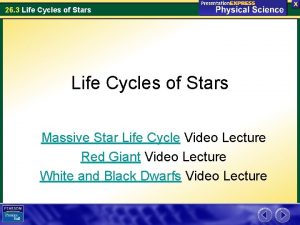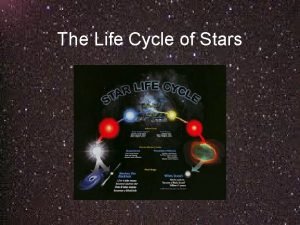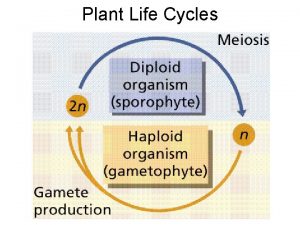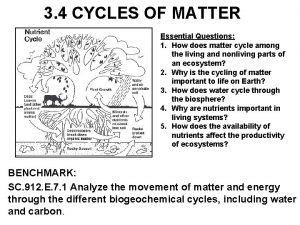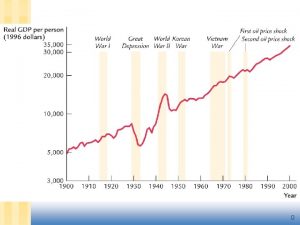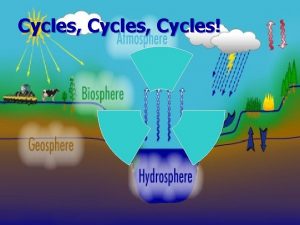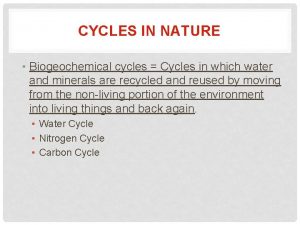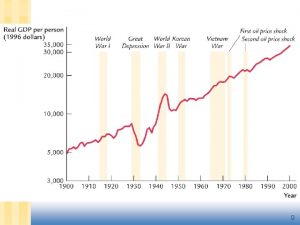Life Cycles of Stars How Stars Form The











- Slides: 11

Life Cycles of Stars � How Stars Form: -The space around stars contains gas/dust � A nebula is a large cloud of dust/gas, some nebulas glow lit by other stars and some are cold and dark that block the light from distant stars behind it

How Stars Form � Stars are created by gravity. � Gravity pulls the nebula’s dust/gas into a denser cloud, as it contracts it heats up � A contracting cloud of dust with enough mass to form a star is called a proto-star � A star is formed when a contracting cloud of dust/gas becomes so dense and hot that nuclear fusion begins

Adult Stars � Spend about 90% of their lives in main sequence (converting hydrogen to helium) � A star’s mass determines the star’s place on the main sequence and how long it will stay there � The amount of gas/dust when the star forms determines the mass of the star

Adult Stars � High mass stars become the brightest/bluest, about 300, 000 times brighter than sun � Because they are bigger and burn so brightly, they only last for a few million years � A yellow star like our sun will remain stable for 10 billion years � A red sequence star may stay in sequence for more than 100 billion years (Formed from small nebulas, 1/10 the sun’s mass)

The Death of a Star � When a star runs out of fuel gravity starts to compress the core and causes it to shrink � Then the star will begin to fuse helium into carbon/oxygen/and other heavier elements � Once all fuel is gone it causes the star to die and turn into a white dwarf, neutron star, or black hole

Low/Medium Mass Stars � Can be 8 times as massive as the sun will eventually turn into white dwarfs � The dying star is surrounded by a glowing cloud of gas called a planetary nebula (Because the 1 st ones found looked like planets viewed through a small telescope) � Once it blows off most of its mass, only its hot core remains (Size of Earth but still about the same mass as before) � Once it cools its called a black dwarf (Takes 20 billion years so the universe has not been around long enough for this to occur)

High Mass Stars � More than 8 times the mass of the sun, grow into super-giants creating new elements , the heaviest being iron � Dies quickly because it consumes its fuel very rapidly � Once the star runs out of fuel the star collapses and explodes as a supernova (Becomes brighter than an entire galaxy) � Produces elements heavier than iron -Rare Earth Elements -Uranium, Platinum, Gold, Etc

High Mass Stars � The heavier elements in our solar system, including the atoms in your body, came from a supernova that occurred in our galaxy billions of years ago � As the supernova spews material into space, its core continues to collapse � If the remaining core has a mass less than 3 times the sun’s mass, it will become a neutron star (This star is dense, electrons/protons are crushed together by the enormous gravity to form neutrons)

High Mass Stars � Neutron stars are much smaller and denser than white dwarfs � A spoonful of a neutron star would weigh nearly a billion tons on Earth � Can spin hundreds of times a second � If a neutron star gives off strong pulses of radio waves it is called a Pulsar

High Mass Stars � If a star’s core after a supernova explosion is more than 3 times the sun’s mass, gravity causes the collapse beyond the neutron star stage � The pull of gravity increases and the speed required to escape the star’s core reaches the speed of light

High Mass Stars � Beyond this point, nothing can escape and a black hole is formed � A black hole is an object whose surface gravity is so great that not even electromagnetic waves, traveling at the speed of light, can escape from it
 Section 26.3 life cycles of stars
Section 26.3 life cycles of stars What is charted on an hr diagram
What is charted on an hr diagram Poems about life cycles
Poems about life cycles Rvguev death
Rvguev death Life cycle of a bird
Life cycle of a bird Style fashion and fad life cycles
Style fashion and fad life cycles Plant life cycles and alternation of generations
Plant life cycles and alternation of generations Xenosporas
Xenosporas виды проектов
виды проектов 4 cycles of life
4 cycles of life Chapter 13 meiosis and sexual life cycles
Chapter 13 meiosis and sexual life cycles The rwenzori mountains mary daniels is a student in england
The rwenzori mountains mary daniels is a student in england
